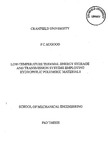JavaScript is disabled for your browser. Some features of this site may not work without it.
| dc.contributor.advisor | Newborough, M. | |
| dc.contributor.advisor | Highgate, D. J. | |
| dc.contributor.author | Augood, P. C. | |
| dc.date.accessioned | 2010-07-26T11:42:26Z | |
| dc.date.available | 2010-07-26T11:42:26Z | |
| dc.date.issued | 1997-04 | |
| dc.identifier.uri | http://hdl.handle.net/1826/4517 | |
| dc.description.abstract | The wide fluctuations that occur in the aggregate electrical demand of a generating utility are punitive with respect to total system efficiency. Demand side management techniques have been applied to reduce such fluctuations including the conversion of electrical energy to thermal energy during periods of low demand for use during peak demand periods. For thermal processes requiring energy above ambient temperature it is feasible to use sensible heat due to the existence of stable storage mediums and efficient methods of heating at the high temperatures required. However where energy is required below ambient temperatures, efficiency of cooling limits the use of sensible heat, hence latent heat storage has been adopted. Conventional cold storage systems use ice banks to store cooling energy at 0°C in order to capture the high latent heat of fusion of water. The rate of discharge for such stores is limited by thermal resistance in the store and the thermal capacity of secondary coolants (such as glycol solutions). This investigated the use of hydrophilic materials to overcome the limitations of current cold-storage technology. Such materials have the capacity to absorb and retain up to 95% by mass of water (or other aqueous solutions) regardless of how the materials is subdivided. Furthermore the thermal properties of the polymers in their hydrated state resemble those of the free hydration fluid, including any phase transitions. By supporting the hydrated materials in a non-freeing, non-aqueous fluid the resultant mixture provides a medium for cold storage that can be pumped and used at the point of load, and is not limited by the thermal resistance of an encapsulating material. Three aspects concerning the utilisation of hydrophilic materials for thermal engineering applications have been investigated; (i) the physical properties of the materials in their hydrated state, (ii) methods of fluidising material in a high density store, and (iii) the heat transfer properties of hydrophilic based slurries while undergoing phase transition. Material tests have shown that currently available hydrophilic materials have thermo- physical properties that depend principally upon the hydrating fluid, regardless of particle size, and are stable over long periods (>3years). Suitable hydration fluids can lower the temperature of the phase transition thus extending their potential as storage mediums beyond those of ice-based technologies. Novel materials, of very high water content (95%) have been produced and investigated. These appear to be very suitable for thermal storage because they increase the maximum achievable energy densities of a fluidised storage system and potentially reduce cost. A number of thermal storage devices to utilise hydrophilic based slurries have been designed and evaluated. The resultant devices has been shown to provide a means of taking hydrophilic materials to, and from, a packed bed and feeding them at a controlled rate into a fluid stream. The thermal charge/discharge rates of such a device are limited only by the choice of external heat exchange systems. An experimental apparatus has been designed to investigate the effects of phase change particles on the heat transfer properties of flowing mixtures. The results have shown that (i) at temperatures above the phase transition temperature the presence of the particles causes an increase in the measured heat transfer coefficient for concentrations above 10% by volume, (ii) there is a significant interaction of particles at the heat transfer surface, and (iii) that under high flow rate conditions, with phase change occurring, heat transfer coefficients are considerably enhanced (ie 80%) above those of the support fluid when used alone or with non-active particles. Further work is recommended to extend this study to produce an engineering prototype storage system for trial evaluation. | en_UK |
| dc.language.iso | en | en_UK |
| dc.publisher | Cranfield University | en_UK |
| dc.title | Low-Temperature Thermal-Energy Storage and Transmission Systems Employing Hydrophilic Polymeric Materials | en_UK |
| dc.type | Thesis or dissertation | en_UK |
| dc.type.qualificationlevel | Doctoral | en_UK |
| dc.type.qualificationname | PhD | en_UK |
